The Smithsonian Connection and the Discovery of the CD 148
by Larry Novak
Reprinted from "Crown Jewels of the Wire", October 2001, page 3
In March 2000, four NIA members had the time of their lives by spending three
days rooting through the "attic" of the Smithsonian Institution and
starting to catalog their insulator collection. The trip was over eighteen
months in planning. It all started prior to the Williamsburg NIA Convention in
1998 when Kevin Lawless contacted Nance Briscoe, the Collection Manager for the
Smithsonian's insulator collection.
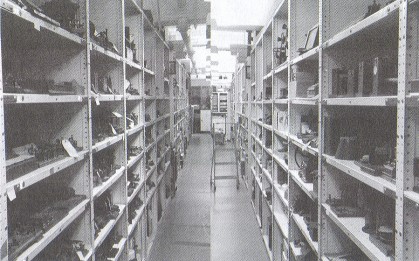
The Nation's "Attic"
Narrow aisles, packed shelves, drawer cabinets
with insulators,
telegraph equipment, patent models, everything tagged and
numbered
so that researchers can have access to history.
Kevin and Doug MacGillvary stopped by the
Smithsonian's Museum of American History for one day on their way to the
Williamsburg National. What they saw there was a treasure trove of insulator
history, but also a collection that was badly in need of a serious cataloging
effort. The Smithsonian had about 1200 insulators in their collection, mostly
housed in drawers in the "attic". Some records were available showing
who donated the object, and when, but no information about CD or U numbers.
Kevin and Doug decided that a concerted effort by the NIA to catalog the Smithsonian collection would be a fun project that would be of tremendous
benefit to the Smithsonian and to the insulator collecting hobby.
Kevin and Doug
arranged a three-day visit to the Smithsonian just prior to the Chesapeake Bay
Insulator Club's (CBIC) March 2000 show. Kevin solicited help and a team was
formed. Unfortunately, Kevin's father became ill a few days before the trip and
Kevin was not able to be part of the team.
Doug MacGillvary and Bob Berry came
into town on the night of February 29. Larry Novak, who lives in the DC area,
picked them up at their motel early on the morning of March 1. We drove into DC
and, after signing in as visitors, met Nance at 8:30 a.m. Nance was extremely
supportive during the whole trip and was excited that the NIA was sending a team
of knowledgeable collectors to help with the cataloging effort.
We were armed
with two laptop computers, two digital cameras, one 35mm camera, a light box,
and a complete set of reference books. Nance first took us on a tour behind the
scenes of the Smithsonian. On the way to get the key to the "attic", we
saw a scene that was reminiscent of Raiders of the Lost Ark - wooden crates
stacked all along the walls in the basement. We then saw Nance's office, her
laboratory working area, and the Museum of American History's research library.
We also met some of the other staff in the Smithsonian's Department of
Electricity and Modern Physics.
We sat in the lab and created a database on one
of the computers. The Smithsonian has catalog cards for most of the objects in
their collection. (We learned some museum terminology - everything in the museum
is called an 'object'). The database contained fields for the information on the
Smithsonian's catalog cards, plus information that we thought would be of
interest to insulator collectors and some other information that Nance thought
would be useful.
Finally, around 11 :00 a.m., we got to see what we all came for
- the "attic". The "attic" is a huge room with
floor-to-ceiling shelves arranged in long rows and floor-to-ceiling drawer units
at the end of the rows. We thought we were dreaming as we (very carefully)
walked down one of the aisles toward the drawer units. The shelves were filled
with things that most of us only dream about-telegraph keys, repeaters,
sounders, battery jars, and all sorts of other old and rare electrical
equipment.
We finally got to the drawers where the insulators are stored and we
all stood around breathless and thrilled as Nance opened drawer after drawer
full of insulators and gave us a peek at what we would be looking at in detail
over the next three days.
Next, we started pulling out individual drawers and
taking pictures of the contents. These were what Nance called "mug
shots" - overviews of the entire drawer.
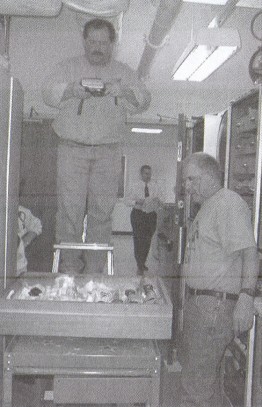
Bob Berry photographs one of the drawers
filled with insulators. Behind Doug
MacGillvary,
you can see rows of drawers in the
cabinet that house the
collection.
At about 12:40 p.m. we finished mug shots of about 30 drawers. Then Nance
started to bring in some interesting objects that were stored on the shelves,
including a virtually mint House insulator.
Some of us were very interested in
the battery jars - there were many nice battery jars, some of which we had never
seen before. We took a few pictures of these; Nance wasn't so interested in
having us spend time on them because she said that she already had lots of
information about them.
Finally, at 1:20 pm we finished all of the mug shots
and got to break for lunch! On the way to lunch, we walked through the
"Hands On History" exhibit in the public area of the museum. They had
a nice telegraph display set up that included a telegraph pole with two cobalt
blue EC&M insulators and some nice rams horns. We would be back here the
next morning before the museum opened to take down the insulators and take close
up photos of them and record the information for the database.
Finally at about
3:45 pm we started cataloging individual insulators. We started with a drawer of
fairly common ones to make sure we had the process down.
After only about an
hour, we had to quit for the day so Nance could catch her train back home. It
was an exciting day and we were all worn out, but only had about 30 insulators
catalogued.
The next day, Ken Willick joined the team.
We again net Nance about
8:30 and took apart the "Hands on History" telegraph pole exhibit and photographed and cataloged each of the insulators.
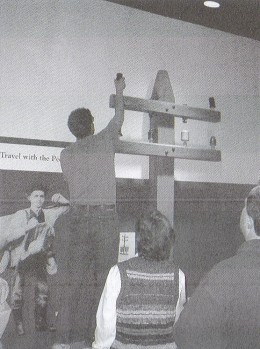
Ken Willick removes one of the cobalt
E.C.& M. Co. insulators from the
display for a closer inspection.
Finally, we got into the meat of the collection. The room where the collection
is stored is in a high security area and we weren't allowed to stay in there
without Nance, so we had to take three drawers into a staging area to start
working on them. We finished the drawer that we started the day before, plus two
drawers with better insulators. There were some insulators that none of us had
ever seen before. There were a number of interesting ramshorns and quite a few
Pond's (at least one almost perfect).
|
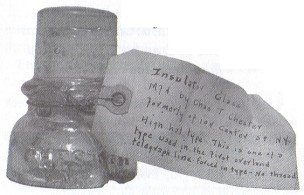
All of the insulators are assigned numbers upon acquiring them for the
collection. Each object had a hand-painted catalog number on the inside of the
skirt of the piece. And, each had an add-free card tag that was either wired to
the piece or tied on with string. Some told quite a story, such as this CD 735
Chester which was part of the Western Union Museum (NY) which has now been
absorbed by the Smithsonian Institution. |
| |
|
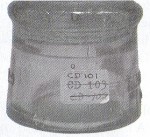
The job of the volunteers is to correct misinformation, properly identify the
insulators, note price guide values and assign a current market value for the
particular insulator in its condition. This Brookfield No.9 pony had been
identified incorrectly twice!
|
By lunchtime, we had about 95 insulators (3 of 29 drawers) finished. After
lunch, we looked at some of Nance's literature and made some copies of some
articles from old, hard-to-find reference material.
Nance wanted to come to the
CBIC show on the weekend and bring one insulator from the collection that would
"wow" everyone. We suggested the cobalt blob, but not long after
lunch, Ken let out a whoop of surprise and we discovered a new (to us) CD glass
insulator. It is a beehive with very weird wire groove - a discontinuous wire
groove that has a very odd shape. No question here - we told Nance that this is
definitely the piece she should take. We suggested that it be nicknamed the
"Briscoe" but Nance wanted to call it the "slice".
The
"slice" turns out to be a CD 148. We have heard different stories about
it. Someone said that it had been seen in the Western Union museum many years
ago, but that it was never properly drawn and cataloged because only a fuzzy
photograph of it existed. When we finally got the information on this piece to
Mr. Woodward, he didn't think this was the piece from the WU museum (See
comments by N .R. "Woody" Woodard at end of article.)
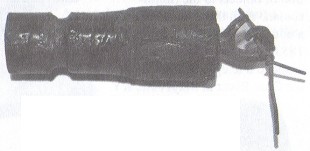
A Kenosha Hook and two Ponds insulators.
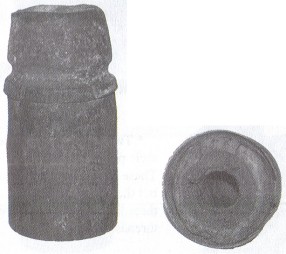
There isn't much information about this piece available, but it was full of
diesel soot, so it had been used and seems to have been in place for quite a
while. There are likely others out there somewhere. Look carefully at those CD
145's that you're ignoring on the poles!
One thing that we found on a catalog
cards implied some connection between Kenosha and Ponds. (See previous page
photos.) We need to follow up on this information.
A number of the good pieces
in the Smithsonian collection came from the Western Union museum. One book that
was frequently referenced in the WU descriptions was Maver's American
Telegraphy, 1903 edition.
The four of us went out to dinner at a local Mexican
restaurant on Thursday night and we just couldn't stop talking about some of the
amazing things that we had seen over the last two days.
On Friday, we catalogued
two more full drawers and then moved on to taking individual photographs of some
of the better pieces.
After lunch, we took pictures of some of the signs and
climbers from the hallway shelves, then back to more individual pictures. Some
of the climbers were like nothing we had ever seen before.
For just a sampling
of some of the other super finds, aside from the "Slice", there were
these insulators (which are all on the web site.)
* Two incredible glass bureau
knobs. We wouldn't even have been sure that these were insulators except that
the Telegraphic Historical Society donated them to the Smithsonian. This society
was formed in 1894 and disbanded in about 1900 when they donated their
collection of objects to the Smithsonian. With these insulators was a note that
they were used, prior to 1853, on masts 150 feet high to suspend a telegraph
wire across the Ohio River at Maysville, KY.
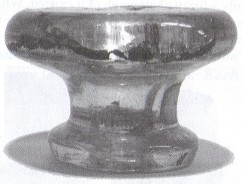
* Two U-978 Bennington style porcelain insulators. These have been seen
before, but they have all been threadless. These two have threads!
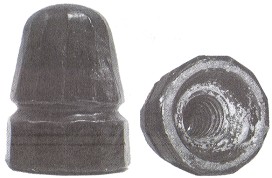
* A U-146 Pass and Seymour porcelain insulator. Until we saw this one, there
was only one other known.
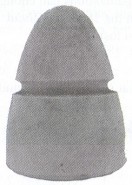
* A pair of CD 1014 Yandell's patent glass blocks - one still embedded in the
original wooden mount.
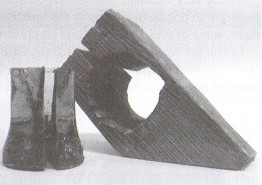
* A beautiful, crude CD 1004 glass block in a wonderful shade of light green.
(This may be what the book describes as "jade green Vaseline").
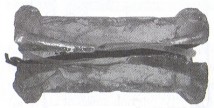
* A metal-covered Brooks ramshorn insulator with a side screw shank. While
the Brooks insulators are not that rare, the ones with the side screw are very
scarce.
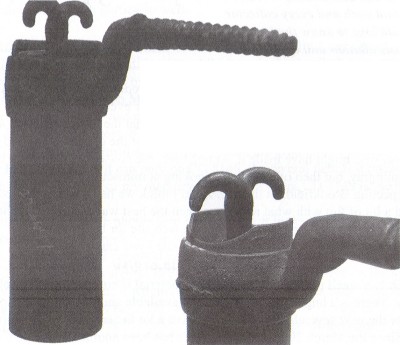
We are very fortunate that several people and organizations had enough
foresight to donate insulators to the Smithsonian in the 1800's. Without them,
some of these jewels would surely have been lost forever.
To end the week, we
all attended the CBIC show. Early in the afternoon, Nance walked in with the
"slice" in her pocket. She pretended to have just come to the show
with her insulator to find out what it was. I understand that one dealer was up to $7,000 before Nance confessed who she was.
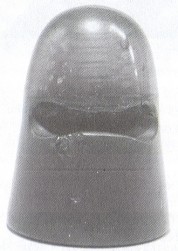 |
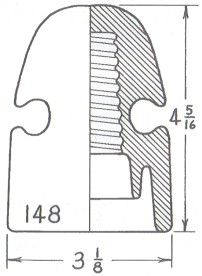 |
| Clean and unused -- NOT! And each and every collector would love to know the
location of installation and application. |
Scale Drawing by Elton Gish |
After
that, the insulator was like a magnet for everyone at the show. Jaws were
dropping as people walked over to see what the excitement was all about. The
insulator was circulated among all of the experts who tried to guess who might
have made it. At one time, the consensus seemed to be Hemingray, but then others
started looking at miniscule features and suspecting Brookfield. In the end, I
don't think we had a consensus, but we had a lot of fun with what may have been
the best walk-in ever at a show.
Since this trip, Larry has developed a web site
for the Smithsonian collection. It is accessible from the NIA site - you can see
it at:
http://www.nia.org/si/
Only a small portion of the available material is
currently on the web site. There is a huge amount of material available and this
site will evolve over the next several years. (It will evolve a lot faster when
Larry retires!)
Since the March 2000 marathon, there has been another
"marathon" in March 2001 when Carol McDougald, Rick Soller and Larry Novak spent three days
continuing the cataloging effort. Elton Gish was scheduled to come to
Washington, but got sick at the last minute and was heartbroken that he couldn't
participate. Another "mini-marathon" was held in July 2001 after the
Atlanta National, when John and Carol McDougald spent two days at the
Smithsonian and Larry joined them for the second day.
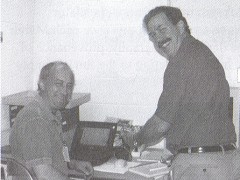
At the July 2001 "mini-marathon", John McDougald
reads off CD
number, embossing, line item and pricing
for the insulator while Larry Novak
adds
the information to the database.
We now probably have about 80% of the collection in the database and have
hundreds of photos. There is still much to be done. The Smithsonian has
literally a room full (maybe two rooms full) of Western Union material that can
serve as valuable reference material. There is plenty of work to do for
years to come and the NIA looks forward to continuing this relationship that
serves both parties so well.
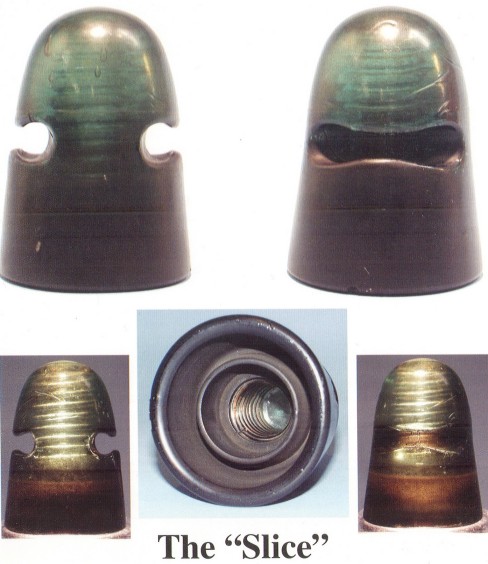
Cover Photo
The CD 148 Assignment was made in 1960. Actually I can't be of much help in
positive identification. All I have is the detailed description of the insulator
as written by me 41 years ago this July, when I spent the day at the Western
Union Museum at their old headquarters at 60 Hudson Street in New York. I had no
camera, but assigned 11 new CD numbers that day. Naturally most of them have
appeared elsewhere since.
If this is indeed an insulator that was among the
group of 50 insulators they had at that time, it can only be CD #148. In several
details it doesn't quite match my notes or my memory. But at this point CD #148
is the best we can do.
I agree that from the photos (see front cover), it looks
Hemingray. I had remembered it as a Brookfield piece (unembossed), also
remembered it as clean and unused; and the mold line a quarter-turn from the
location mandatory with the design as in photos. If the mold lines were on the
side away from the grooves, it would be impossible to open the mold with the
design of grooves as it is.
So - - this is CD #148
N. R. "Woody" Woodward
The Smithsonian Institution preserves objects tucked into areas that many of
us have never seen, let alone knew they even existed.
For many years the
insulator collections housed or exhibited in the National Museum of American
History have been selectively researched, photographed, dusted, and moved many,
many times.
Recently, the Museum staff has had an opportunity to focus their aim
directly upon a knowledge base and bring together a group of folks from the NIA
and CBlC in what is warmly named the Annual Insulator Marathon. This marathon
has taken on a rewarding presence each March with activity and resources, such
as digital photography, provenance of the object, value identification and
historical dating to the fun of simply being wooed by miles of line captured in
old photographs, journals, books, letters and ledgers.
Personally, I thank all
those hobbyists who have dedicated their time in providing the Smithsonian with
resources so desperately needed -- of special note, an entire collection of
Crown Jewels of the Wire from the first issue, books that are out-of-print,
insulators we had never collected, questions answered, continuing documented
research, and one insulator in particular we had - but never had a name,
"the SLICE", and most impressively a web presence available to all at
the National Insulator Association website: http://www.nia.org/si/
The marathon
affiliation in digital form is a new collecting venue and one that will enable
us to connect with. The information gathering is paramount in that it supports
the objects so that the past will be accessible even when the lights are off in
our Nation's Attic.
The Smithsonian openly invites all who have interest and
desire to share their hobby, their research and their enthusiasm.
With warm
regards for a brighter future,
Nance L. Briscoe, Department of Electricity
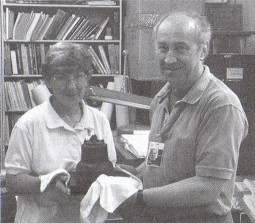
Nance Briscoe and Larry Novak carefully handle
the ironclad, glass-lined
House Insulator. Just one
of the treasures one finds on the shelves of the
nation's "attic."
| 